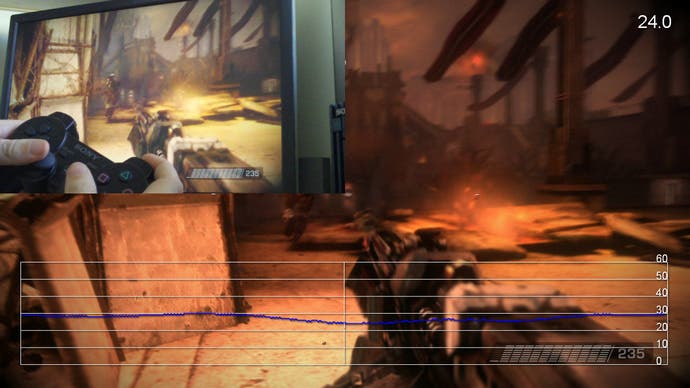Coming Soon: The Definitive Game Latency Showdown
It's going to involve a huge amount of effort and several pieces of technology working in tandem, but I think it's possible to produce a comprehensive investigation into how much latency is built into today's console and PC releases. Players often complain about how unresponsive certain games are, but can this actually be quantifiably and accurately measured? And just how much does a drop in frame rate impact response? Even running in optimum conditions, just how much lag is built into the top-selling console titles?
I'm hoping to cover a lot of ground in this piece across multiple consoles, but I'm starting out by looking at one of the more controversial releases of recent times: Guerrilla Games' Killzone 2, a game that received a great amount of criticism for its apparently "laggy" controls. Personally I thought it was more a case of a heavy sense of inertia being deliberately programmed into the game, but by the time this process is complete, we'll have some real data to chew over and direct comparisons between games in the same genres running at the same frame rates. Plus we can analyse the difference the later patch made to the initial release to see what changes, if any, were implemented. Here's a couple of rough preview shots of the sort of thing you'll be seeing in video form in the final piece.


So, what's going on? The game is captured via our TrueHD system, while simultaneously being recorded at 60FPS with a 720p high definition video camera. Frame rate analysis is then carried out on the captured clip and the cam stream is then synchronised and overlaid on top. With the controller in view, we can accurately measure the amount of time between a button press and the resultant action on-screen, plus with the frame rate graphs visible we can pin-point high points and low points of overall game performance and correlate them to the response from joypad commands.
Flatscreen displays incur their own latency penalties of course, but don't worry, we've thought of that too and any lag in our display will be factored out of the results. Other factors such as wired versus wireless controllers will also be evaluated to assure the purity of the result.
I expect that those results will be surprising and maybe, just maybe, might explain why (theoretically at least) the concept of systems like OnLive might not be quite the "Cloud" cuckoo land we think it is. If we are already conditioned to a certain delay in response, ultra high-end PC gaming hardware could perhaps in theory claw some of that back, mitigating the issues of transmitting data over IP. So yes, we'll be including a bit of PC in the tests too.
It's game performance measurement in its purist form, and hopefully the preview shots illustrate the transparency we'll have in our data – you'll be able to see the actual button presses, the absolute synchronisation between the cam-screen and the capture, and so the results should be beyond doubt. So the question is... what games should we be covering?







